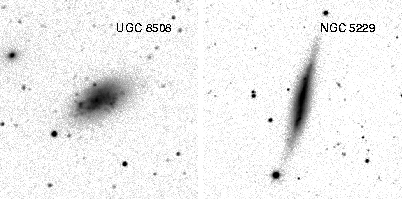

Up: Structure and stellar content galaxies
The M101 group, with  Mpc (Karachentsev 1996),
is the most
distant one in the 10 Mpc volume. It is also the poorest group of all,
including the LG. It is completely dominated by M101 itself: the
second-ranked group member, NGC 5585, is already 3 magnitudes fainter
than M101. Only 13 members and possible members of the group are known
to date, half of which are lying very close to M101 and can therefore
be regarded as M101 satellites. With one exception (the dwarf
elliptical UGC 8882) they are all late-type dwarfs (Sd, Sm, Im). One
peculiar feature of the group is its luminosity function: the
population of very faint and diffuse dawarfs (elliptical or
irregular), which is so frequent elsewhere, is apparently simply
missing here (the faintest member known is as bright as
Mpc (Karachentsev 1996),
is the most
distant one in the 10 Mpc volume. It is also the poorest group of all,
including the LG. It is completely dominated by M101 itself: the
second-ranked group member, NGC 5585, is already 3 magnitudes fainter
than M101. Only 13 members and possible members of the group are known
to date, half of which are lying very close to M101 and can therefore
be regarded as M101 satellites. With one exception (the dwarf
elliptical UGC 8882) they are all late-type dwarfs (Sd, Sm, Im). One
peculiar feature of the group is its luminosity function: the
population of very faint and diffuse dawarfs (elliptical or
irregular), which is so frequent elsewhere, is apparently simply
missing here (the faintest member known is as bright as  ).
We have therefore made an attempt to find new candidate members
on deep POSSII Schmidt films, but found only one additional possible
member (the BCD MGC9-23-21). A recent blind HI survey of the M101
area has also not resulted in a single new member of the group
(Kraan-Korteweg et al. 1999, in preparation). It will take surveys of
highly increased sensitivity to uncover the sought-for exponential
rise of the luminosity function of the M101 group.
).
We have therefore made an attempt to find new candidate members
on deep POSSII Schmidt films, but found only one additional possible
member (the BCD MGC9-23-21). A recent blind HI survey of the M101
area has also not resulted in a single new member of the group
(Kraan-Korteweg et al. 1999, in preparation). It will take surveys of
highly increased sensitivity to uncover the sought-for exponential
rise of the luminosity function of the M101 group.
 |
Figure 1:
Sky map (conical equidistant projection) of the M101 group
and surrounding field. The galaxies are coded according to group
membership and types. Group members and possible members are indicated
by triangles and inverted triangles, respectively, field galaxies by
squares. Early types are represented by filled symbols and late types
by open ones. M101 is plotted as a large cross. The galaxies M51 and
M63 are shown with smaller crosses. UGCA 342 is shown as a cross along
with M63 in the lower right of the map (see Sect. 6) |
Table 1:
M101 members (M), possible members (PM) and Field dwarfs
(F) observed
|
|
In Table 1 we give a complete list of the 11 presently
known members (M) and possible members (PM) of the M101 group
as well as 10 field (F) dwarfs that were imaged during the same run.
This list was prepared by B. Binggeli based on the catalogue of
Schmidt & Boller (1992a). A map showing the
distribution of these objects on the sky is shown in Fig. 1,
where the galaxies are coded according to their type and group
membership. A gallery of images is given in Fig. 2. It
should be noted that the objects listed in Table 1 and
the images displayed in Fig. 2 include all M101
group members known to date with the exception of the two giant
members M101 and NGC5585 for which data and images are given in
Sandage & Tammann (1974, 1987).
The photometry of the 21 objects listed in Table 1 is
based on images taken during eight nights in March 1997 on the
 telescope of the Observatoire de Haute-Provence
(OHP). They are 40 minute Cousins B and 20 minute Cousins R
exposures. The camera used was the No. 2 Tektronix
telescope of the Observatoire de Haute-Provence
(OHP). They are 40 minute Cousins B and 20 minute Cousins R
exposures. The camera used was the No. 2 Tektronix
 CCD. One pixel corresponds to
CCD. One pixel corresponds to  , giving a
frame size of
, giving a
frame size of  . The gain was set to
. The gain was set to
 per ADU, and the CCD was read out in the fast
mode, with a readout noise of
per ADU, and the CCD was read out in the fast
mode, with a readout noise of  . The seeing during
the observing run varied between
. The seeing during
the observing run varied between  and
and  (FWHM),
which is relatively poor but sufficient for our purposes.
(FWHM),
which is relatively poor but sufficient for our purposes.
 Figure 2:
B
Figure 2:
B-band CCD images (except NGC 5204 for which only a
R-band
image was available) of the M101 group dwarf members and the dwarfs in
the vicinity of M101, shown in the same order as listed in
Table
1. The scale is the same for all pictures and
is given by the size of one image side

. North is up and
east to the left
 Figure 2:
Figure 2:
continued
 Figure 2:
Figure 2:
continued
![\begin{figure}
\begin{tabular}
{c}
\includegraphics [width=6.75cm]{ds8453fm.eps}
\end{tabular}\end{figure}](/articles/aas/full/1999/11/ds8453/Timg25.gif) Figure 2:
Figure 2:
continued


Up: Structure and stellar content galaxies
Copyright The European Southern Observatory (ESO)











![\begin{figure}
\begin{tabular}
{cc}
\includegraphics [width=6.75cm]{ds8453fk.eps}
&
\includegraphics [width=6.75cm]{ds8453fl.eps}
\\ \end{tabular}\end{figure}](/articles/aas/full/1999/11/ds8453/Timg24.gif)
![\begin{figure}
\begin{tabular}
{c}
\includegraphics [width=6.75cm]{ds8453fm.eps}
\end{tabular}\end{figure}](/articles/aas/full/1999/11/ds8453/Timg25.gif)